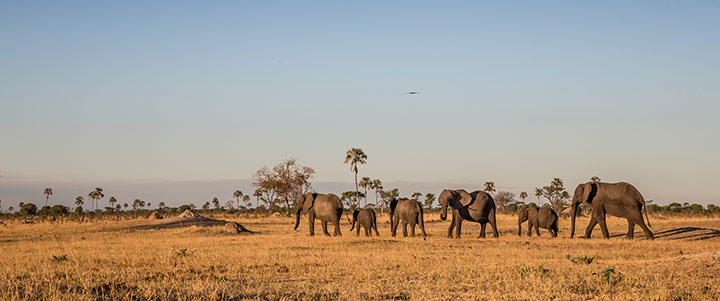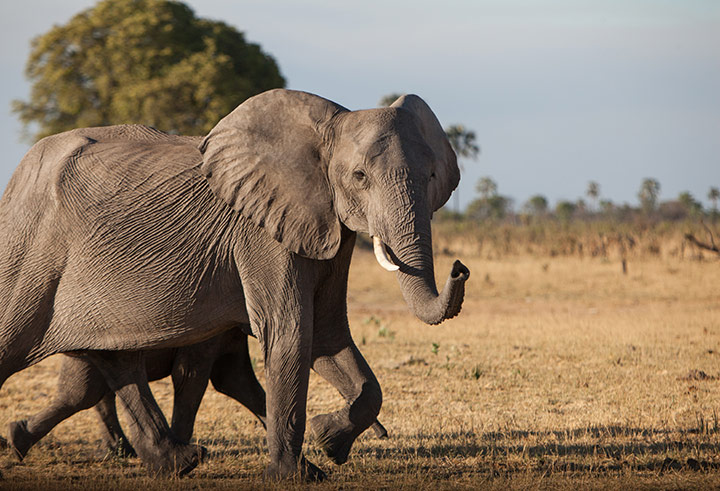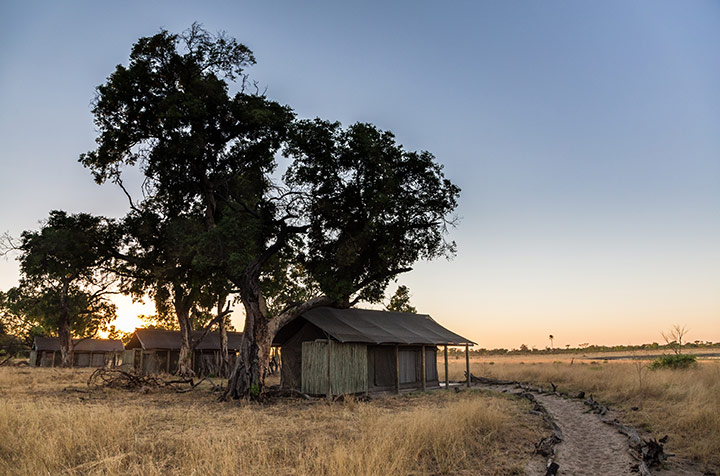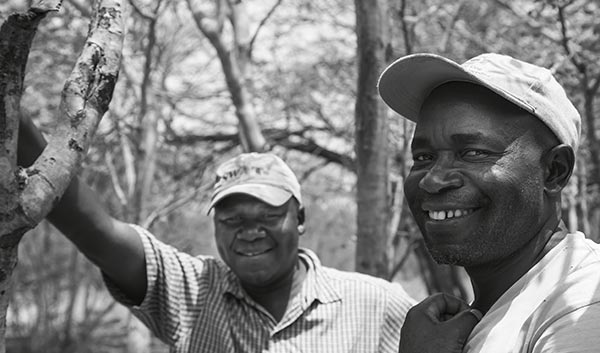Zimbabwe’s largest, and greatly beloved, Hwange National Park has had a tough time in the last 20 years. At its heart is the issue of water. Don Pinnock and Chris Davies consider the human endeavour that has gone into stabilising the situation in Hwange and what it has meant for its most demanding inhabitants – the elephants.
It’s all about the elephants
By Don Pinnock
The full moon rose over the waterhole like a huge golden coin, silhouetting elephants in its rippling reflection. The extraordinary scene was suddenly blocked by a giant foot then another as a family of tuskers walked past within touching distance of the ground-level hide I was in.
The quest had been to see how elephants in Hwange National Park were doing, and here they were in their hundreds, luxuriating in the cool evening and abundant water. They walked so silently on their spongy feet that we could hear the whip poor will call of a distant fiery-necked nightjar and the soft diesel thump of the water pump 100 metres away.

The relationship between a mother elephant and her offspring is protective, reassuring and comforting. Mothers and other family members caress the young in many different ways, by wrapping a trunk over the calf’s back leg or back or just sidling up to them, rumbling gently. Image by Don Pinnock.
The base for my quest was Davison’s, a tented camp in the park’s remote, southeast Linkwasha Concession. It was named after Hwange’s founder, Ted Davison who, at the age of 22, began campaigning to have the area proclaimed a game reserve, protected from hunters and poachers. His efforts were rewarded in 1928 and today it’s Zimbabwe’s largest park about the size of Switzerland.
In the dark days of land invasions and with a currency in free fall, Hwange fell on hard times, with few tourists and empty coffers. Hunting for the pot and poaching were rife and only the most resilient lodge and concession owners hung on in hope.
The park comprises Kalahari sandveld with teak and mopane woodlands as well as dry acacia scrub interspersed with salt pans and grasslands. Prior to Davison’s involvement, species diversity would be enormous during the rainy season, but in dry times or when the rains failed, many animals migrated. The solution, and the only way to make Hwange viable for wildlife, Davison realised, was to sink boreholes and provide year-round water.
In the late 1990s the park ran out of cash. Funding to the park’s authorities dried up, and fuel and spares became nearly impossible to find. Many pumps were shut down and the animals suffered. Private concessions kept some of them going but when drought struck in 2004/2005, the situation became dire. Thousands of animals died or were forced to migrate out of the park in search of water. It took a collective effort of NGOs, the Zimbabwe Parks and Wildlife Management Authority and private individuals to step in to get Hwange’s heart beating again. Thanks to them, water is widely available, even at the height of the dry season.
Wilderness Safaris, which runs Davison’s and several other camps in the Linkwasha Concession, is one of the private operators which has put down boreholes and this has paid off handsomely in wildlife numbers.
A few nights before full moon, after a day of sightings that included lions, leopards, baboons, sable and a great many elephants, we were sitting round the fire in a shroud of starlight when somebody gasped and pointed. Shielding our eyes from the firelight, we could see the huge forms of elephants only metres from where we sat.

Elephants can drink up to 200 litres of water a day and stay close to Hwange’s artificial water sources. Image by Don Pinnock.
‘There’s a water fountain right there,’ said Wilderness Safaris Zimbabwe CEO Ron Goatley.
‘They love fresh water and can’t resist strolling up for a suck. They’re pretty chilled around here.’
There’s still poaching and ration hunting in the park, but from the demeanour of the animals, that’s not a problem in the concession.
‘There is poaching of course,’ said Goatley. ‘At the escalating price of ivory that’s not surprising. But we curb ration hunting here by supplying the surrounding communities with goats. We also help them with education and medical care. The relationship works well both ways.’
Davison’s strikes a delightful balance between wild living and pure luxury and overlooks an open plain and a waterhole that’s never short of entertainment. The routine seems to be baboons at dawn, zebras and antelope during the morning, elephants in the midday heat and buffaloes plus more elephants each evening. As the night deepens and with a good torch the eyes of prowling cats reflect back yellow points of trouble.
More than anything else, though, the Linkwasha Concession in the right season is about elephants. However much Zimbabwe’s border posts can be a hassle, its ‘carbon tax’ irritating and its road-tax holdups annoying, Hwange remains one of the most exciting wildlife experiences in Southern Africa. It’s worth putting up with a few minor bureaucratic irritations to watch the full moon over a waterhole in the company of several hundred elephants.

A breeding herd crosses the ilala palm-dotted plains after an afternoon drink. Image by Chris Davies.
The numbers game
By Chris Davies
With virtually no surface water and less than 10 millimetres of rain for at least half the year, Hwange National Park needs constant human intervention to survive. Sixty-odd diesel pumps, most running 24/7 during the eight-month dry season, provide nearly all of the drinking water. These pumps have become its lifeblood, thumping away across the plains and making a year-round sanctuary of an otherwise arid land. Maintaining Hwange’s wildlife is a delicate situation that’s constantly under threat.
When drought struck in 2004/2005, the devastation prompted a group of concerned Zimbabweans to form the Friends of Hwange Trust (FOH Trust), a non-profit organisation that supports the parks authority and private concessions in the campaign to keep Hwange’s pumps going.
‘It’s a huge challenge,’ says David Dell, one of the NGO’s five trustees. ‘The animals get water from natural pans in the rainy season and this can last for a while if the rains are good, but for the most part, water must be pumped.’
And with a park as big as Hwange, it’s very much a collective effort.

The water hole at Hwange’s Scott’s Pan. Image by Chris Davies.
‘Together with the parks authority, Wildlife and Environment Zimbabwe and the private concessions, we’re responsible for all the water in the park,’ says David. ‘It’s unclear how many pumps went out of action in the toughest years, but at its peak about 60 were operational. Including the few boreholes that provide water for the camps, we’re currently maintaining 65. It’s great to be back up to previous levels, but with boreholes prone to silting, and troughs and pipes getting damaged, there’s always a lot to do.’
It’s a job with a very demanding, and very thirsty, clientele.

Elephants drinking at Broken Rifle Pan in Hwange National Park. Image by Chris Davies.
In October each year, the membership-based organisation Wildlife and Environment Zimbabwe conducts a 24-hour animal census. In 2014, 34773 animals were recorded across 41 species, and of these, a whopping 21290 were elephants. With an adult elephant drinking between 150 and 200 litres of water a day, it’s easy to see why the pressure on the park’s pumps is so enormous.
Wilderness Safaris runs the largest private concession area in Hwange and manages 14 of the park’s 65 pumps. Arnold Tshipa, their head ecologist in Hwange, has a particular passion for elephants and has recently collared eight of them to better understand their numbers and movements. I’d seen hundreds in just my first few hours in the park and had been told there were an estimated 40 000 to 60 000 in total. When I posed the question to Arnold he was a little more cautious.
‘If you say 50000 elephants in a conservation meeting around here, eyebrows are raised all round,’ said Arnold with a smile. ‘It’s not that there aren’t tens of thousands of ellies in Hwange – the annual 24-hour census has recorded over 20000 in three of the last four years. But their migratory patterns are still not fully understood. It’s likely that significant numbers migrate out of the park in the rainy season and exactly how many are permanent residents is not really known.’
Arnold’s collaring project is designed to determine just that. Not much is known about how high local densities and individual dominance and status impacts on elephant behaviour, and tracking the animals through the wet-dry seasonal cycle will provide valuable insight into how many elephants are staying in the area even when water can be found elsewhere.
The exact numbers may be debated, but there’s no doubt that in the dry season, Hwange is an essential water source for a mammoth number of elephants. And, as elephants have been doing for thousands of years, they’re changing the ecology around the park’s pans.
‘Elephants have a massive impact on the bush around water points,’ says Arnold. ‘This impacts on other grazers in terms of both food and access. Elephants also tend to dominate the water points, making it hard for other animals to come for a drink.’
Hard, but not impossible. In the 2014 24-hour census, 3122 buffalo, 2931 impala and 1563 zebra were still recorded, as well as 83 lion, 233 hyena, two cheetah and three leopard. With varying weather conditions and the increasing number of volunteers and pans counted over the years, it’s hard to spot trends, but 2014 did record the second highest total count since 2005 only a few hundred shy of the 2011 high.
Poaching is, of course, a factor but Arnold remains positive and insists that the park’s wildlife is at most risk from a shortage of water a repeat of 2004 when fuel was scarce and the rains didn’t come.
‘It’s an all-round effort, with anti-poaching units and water-supply teams all playing an essential part,’ he says, ‘but it’s the water supply that has the biggest impact on the game numbers here.’
It means pumping, and the thump of diesel engines is a constant feature in the soundscape of Hwange. The problems of diesel dependency, as well as the obvious environmental concerns, have not escaped the park’s custodians. Wind pumps have been tried and will continue to be used where possible, despite the low water output and their susceptibility to storm damage. Solar is a more promising avenue, although expensive.

Elephants will cover huge distances in search of water. Image by Chris Davies.
In early 2015, three new Lorentz solar pumps were installed through funds raised by the Friends of Hwange Trust, bringing the total now in the park to 10. They may be expensive to install and still yield lower volumes than modern diesel pumps, but with Wilderness Safaris alone having spent about R270 000 on fuel last year, the long- term savings are clear.
It’s quite something to think that Hwange, a man-made park, is the 10th largest reserve in Africa and one of the last places on Earth where elephants can still congregate in such large numbers. When Ted Davison first transformed this huge tract of land he took advantage of what was available and it’s still all that is available. The inexorable thump of diesel pumps is as endemic to the park as its wildlife.
And while that sound might one day fade completely to be replaced by solar, if the bubbling ceases, so does Hwange. Man created it, and it’s up to us to look after it.
Poaching in Hwange
Stories of army-ration hunting, unchecked snaring and shady smuggling deals abound in Hwange, which has led to a perception that the park’s wildlife has vanished. While poaching and snaring is certainly a problem, as it is in many of Africa’s parks, the game has certainly not been wiped out. Regular patrols are showing success and snares and traps are being removed. It’s the kind of news that can be spun both ways of course – the more snares found, the worse the problem, but the essential work continues despite occasional setbacks. In 2014, the anti-poaching unit that patrols Wilderness Safaris’ concession areas removed 205 snares and two gin traps along the park’s southeastern border. A temporary funding shortage resulted in patrols being suspended towards the end of the year so that only 129 were conducted, down from 189 in 2013.
Plan your trip
Getting there
South African Airways and British Airways fly from Johannesburg to both Victoria Falls (Zimbabwe) and Livingstone (Zambia), while Airlink flies direct to Livingstone and low-cost airline FlyAfrica flies from Johannesburg to Victoria Falls. Return flights start from about R1900. Wilderness Safaris offers transfers from both airports to its camps. Alternatively, all visitors can access the park through the main gate at Main Camp which is just off the A8 highway, 190km south of Victoria Falls, or 280km north of Bulawayo.

When to visit
Hwange’s huge elephant herds are best seen in winter and the park is busiest between April and November. The rainy summer season sees fewer guests, but is the best time for spotting migratory birds.
Where to stay in Hwange
Wilderness Safaris’ Davison’s Camp is a classic tented camp with en-suite units tucked beneath a grove of false mopane trees that overlook a busy waterhole. Full board (including twice daily game drives, laundry and park fees) is from R2900 per person sharing for SADC residents. Wilderness Safaris also runs Little Makalolo tented camp and the luxurious Linkwasha Camp, which has recently been revamped and upgraded and is now open for bookings. Tel +27118071800.

The discreetly spaced chalets at Davison’s Camp face the pan under the shade of leafy African rosewood (false mopane) trees. Image by Chris Davies.
Camping is available outside the concessions in the park’s three main camps: Main Camp, Sinamatella and Robins Camp, which also offer lodge and chalet options. Camping is from $15, lodge accommodation from $75 per two-bed unit and two-bed chalets from $35. There are a number of exclusive campsites scattered throughout the park. These sites, which cost $30 per person, are private at night although the ablutions are open to all visitors during the day. Visit zimparks.org to book.
Need to know
Visitors to Zimbabwe require a visa (unless you’re travelling on a SA passport), a valid passport with at least four blank pages, and sufficient funds for the duration of your stay. A yellow fever certificate is also required. A dual ‘univisa’ for both Zimbabwe and Zambia is also available. Hwange is a malaria area so consult your doctor before visiting.
Help at borders
The Zimbabwe Tourism Authority has posted staff at the Beitbridge border to assist visitors. The area manager is Bertha Mutowembwo, [email protected], Tel +26329823640. For ZimParks help, contact Christina Mhuriro on [email protected] or Tel +263772432148.
This article first appeared in the March 2015 issue of Getaway magazine. Please note that all prices were correct at time of publication, but are subject to change at each establishment’s discretion. Please confirm latest prices before travelling.
Urgent Appeal from Friends of Hwange
October 2015
It is hot, dry and it’s desperate! As you all relax and prepare to enjoy your weekend, we urge you to think about the wildlife in Hwange and how much life depends on water.
It’s crisis time in Hwange, we are pumping all the pans 24/7 and using 2000 litres of diesel a week. We cannot stop until it rains. If the animals don’t drink, they die. We have had support from people abroad, and from a few people locally, and for that we are hugely grateful, but we need more local support. Come on Zimbabwe, it’s your National Park, if you have an extra $5, $10, or $20, donate it to Friends of Hwange so we can provide water for ALL the wildlife in Hwange National Park.
Contact Dave Dell: [email protected]
Visit our website: www.friendsofhwange.com/donate
Follow us on facebook: www.facebook.com/FriendsOfHwange





















